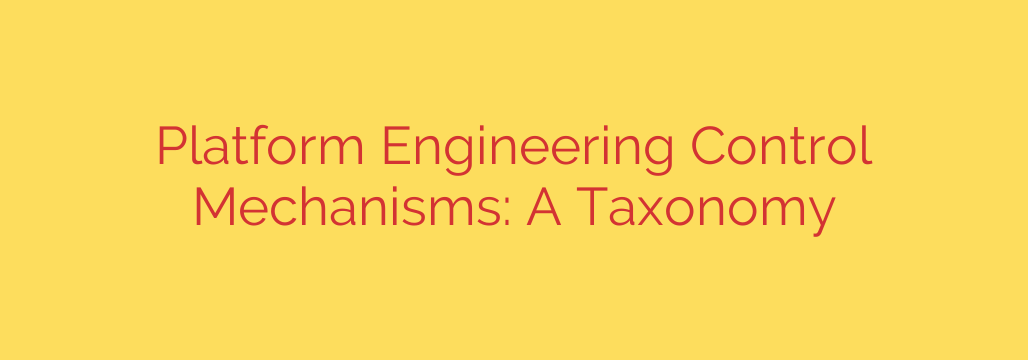
The Four Types of Platform Engineering Controls You Need to Know
In the world of modern software development, speed and stability often feel like opposing forces. Developers want the freedom to innovate quickly, while the organization needs guardrails to ensure security, compliance, and reliability. Platform engineering aims to solve this dilemma by creating an Internal Developer Platform (IDP) that offers a paved “golden path” for development. The secret to making this path both efficient and safe lies in a well-designed set of control mechanisms.
These controls aren’t about restricting developers; they are about abstracting complexity and embedding best practices directly into the workflow. By understanding the different types of controls, platform teams can create a resilient, secure, and high-velocity engineering environment. Let’s break down the four fundamental categories of platform engineering controls.
1. Architectural Controls: Setting the Foundational Blueprint
Architectural controls are the high-level, foundational decisions that shape your entire technology ecosystem. Think of them as the zoning laws for your software city. They are typically made early in the process and are difficult to change, defining the core components and standards that all development teams will use.
These decisions are critical because they ensure consistency, interoperability, and long-term maintainability across the organization.
Key examples of architectural controls include:
- Standardizing on a specific cloud provider, such as AWS or Google Cloud, to leverage consistent APIs and IAM models.
- Mandating Kubernetes as the sole container orchestration platform to create a uniform deployment target.
- Selecting a default database technology, like PostgreSQL, for all new transactional services.
- Choosing a primary programming language or framework for specific domains to streamline tooling and expertise.
Actionable Advice: Involve security and operations teams in these foundational architectural decisions. Embedding security principles and operational requirements at this stage is far more effective than trying to bolt them on later.
2. Static Controls: Shifting Left for Proactive Quality
Static controls are automated checks that run before an application is ever deployed. They are a core component of the “shift-left” philosophy, where quality and security checks are moved earlier in the development lifecycle—typically within the CI/CD pipeline. The goal is to catch errors, vulnerabilities, and policy violations when they are cheapest and fastest to fix.
By automating these checks, you reduce the cognitive load on developers and human reviewers, ensuring that only code meeting a certain quality bar can proceed toward production.
Key examples of static controls include:
- Linting and code formatting checks to enforce consistent coding styles.
- Static Analysis Security Testing (SAST) tools that scan source code for known security vulnerabilities.
- Policy-as-code validation using tools like Open Policy Agent (OPA) to check infrastructure-as-code (e.g., Terraform or CloudFormation) against organizational policies.
- Unit and integration test coverage requirements that must be met before a merge is allowed.
Actionable Advice: Integrate static analysis tools directly into developer IDEs and Git pre-commit hooks. This provides immediate feedback, allowing developers to correct issues instantly without waiting for a CI pipeline to fail.
3. Runtime Controls: Guardrails for Live Applications
While static controls check code before deployment, runtime controls enforce policies while the application is actively running in a live environment (like staging or production). These controls are essential for security, stability, and operational governance in dynamic, distributed systems. They act as the real-time immune system for your platform.
Runtime controls protect the system from unexpected behavior, malicious activity, and resource contention, ensuring that applications operate within safe and predefined boundaries.
Key examples of runtime controls include:
- Network policies within Kubernetes that strictly define which services can communicate with each other.
- Resource quotas and limits that prevent a single buggy service from consuming all available CPU or memory and crashing the entire cluster.
- Identity and Access Management (IAM) policies that enforce the principle of least privilege for applications accessing cloud resources.
- Web Application Firewalls (WAFs) that block common attack vectors like SQL injection and cross-site scripting.
Security Tip: Always implement the principle of least privilege in your runtime controls. A service should only have the exact permissions and network access it absolutely needs to function. This dramatically reduces your blast radius in the event of a compromise.
4. Procedural Controls: The Human Element of Governance
Not everything can be automated. Procedural controls are the human-centric processes, workflows, and rituals that ensure accountability, knowledge sharing, and a high standard of quality. They govern how people interact with the system and with each other. While they may seem “low-tech,” they are often the glue that holds a mature engineering culture together.
These processes ensure that critical changes receive proper scrutiny and that the team has well-defined playbooks for managing both planned and unplanned events.
Key examples of procedural controls include:
- Mandatory peer code reviews requiring at least one or two approvals before code can be merged.
- A formal architectural review process for introducing new technologies or major system changes.
- Documented incident response runbooks that guide engineers on how to handle outages and security events.
- On-call rotation schedules and escalation policies to ensure 24/7 system availability.
Actionable Advice: Document your procedural controls clearly and, where possible, use automation to support them. For example, use CI/CD pipeline rules to automatically enforce the “two-approver” code review policy. This reduces friction and ensures the process is followed consistently.
Building a Resilient and Efficient Platform
A successful Internal Developer Platform is built on a thoughtful combination of all four types of controls. Architectural controls provide the foundation, static controls ensure quality before deployment, runtime controls protect live systems, and procedural controls govern human interaction.
By carefully layering these mechanisms, platform engineering teams can create a development ecosystem that is not restrictive but empowering. They provide developers with the freedom to move fast on a “golden path” that is secure, reliable, and compliant by design, ultimately enabling the entire organization to deliver better software, faster.
Source: https://cloud.google.com/blog/products/application-modernization/platform-engineering-control-mechanisms/








